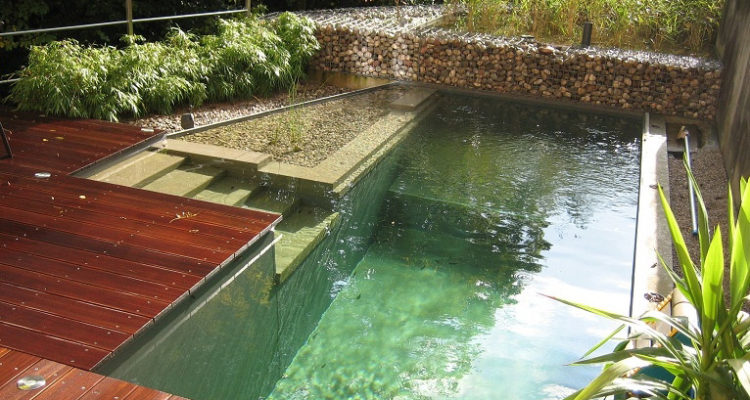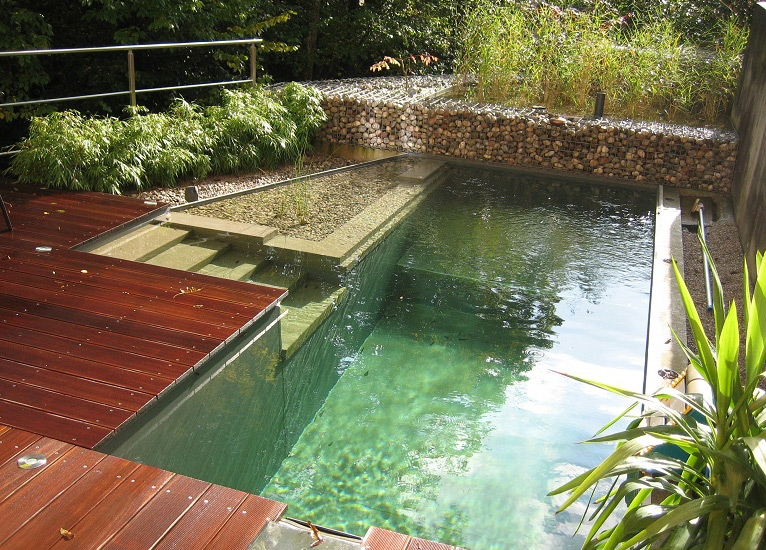Yes, Eco-Friendly Backyard Pools Do Exist
Installing a backyard pool doesn’t have to be at odds with your eco-conscious lifestyle. The green marketplace is doing more to meet the demands of consumers who enjoy the luxuries of life but don’t want to sacrifice the environment to get them. Even the swimming pool industry is creating increasingly responsible products that help offset a pool’s environmental impact.
The first step to a greener backyard pool is to understand the pros and cons of the three main types of in-ground pools that are available.
Concrete or Gunite Pool
A traditional gunite swimming pool usually adds the most value to your home, but the maintenance costs and time are greater compared to other types, especially if you live in an area with extreme weather. Freezing temperatures can cause cracks in the pool, which require expensive and wasteful repairs such as replastering and acid washing.
Gunite and concrete pools are the least eco-friendly choice when it comes to chemical use, too. The tiny crevices in the pool walls create an excellent environment for algae growth, requiring more frequent and chemical-laden cleaning.
On the plus side, a concrete pool provides the most flexibility in size and shape, meaning you can take greater advantage of your site’s sunny and shady areas when designing the pool and surrounding lounge areas.
Fiberglass
For a fiberglass pool, the ground is excavated and a pre-fabricated fiberglass shell is lowered into the hole. Fiberglass pools are quick to install, usually taking up to three weeks to complete. Fiberglass pools provide the smoothest surface of any in-ground pool, and a smooth surface means less algae growth, less cleaning and fewer chemicals, according to GreenPool.info.
Fiberglass pools retain warmth better than concrete pools and require less heating. Fiberglass is both flexible and strong, and though it can be damaged, the material is crack-resistant and requires little maintenance overall. Design options aren’t as flexible as with a concrete pool, but many upgrades, shapes and sizes are available.
Vinyl-Liner Pools
Vinyl-liner pools are generally the least expensive option and the quickest to install. They are constructed by securing a series of panels around the excavated hole and then layering the vinyl liner over the panels and pool bottom as a last step. Using panels made from plastic instead of steel eliminates the concern of heavy metals leeching into the ground. The need to replace liners frequently has given vinyl-lined pools a poor green rating in the past, but according to PoolProducts.com, choosing the right quality liner for your pool is essential. For example, some in-ground liners include warranties for up to 25 years. Like fiberglass pools, the sides of a vinyl-liner pool are smooth and resistant to algae growth, and they are typically low-maintenance.
In addition to choosing the best type of pool for your site and situation, you can decrease the environmental impact of a backyard swimming pool by using pool covers, solar heaters and environmentally friendly cleaning products. Keep in mind that when the fun is literally in your own backyard, you’ll stay at home more—thereby reducing driving time to the city pool or waterpark, where all types of waste and environmentally hazardous practices may be happening. It is possible to stick with your green principles and enjoy a few luxuries; being a well-informed consumer is the place to begin.




